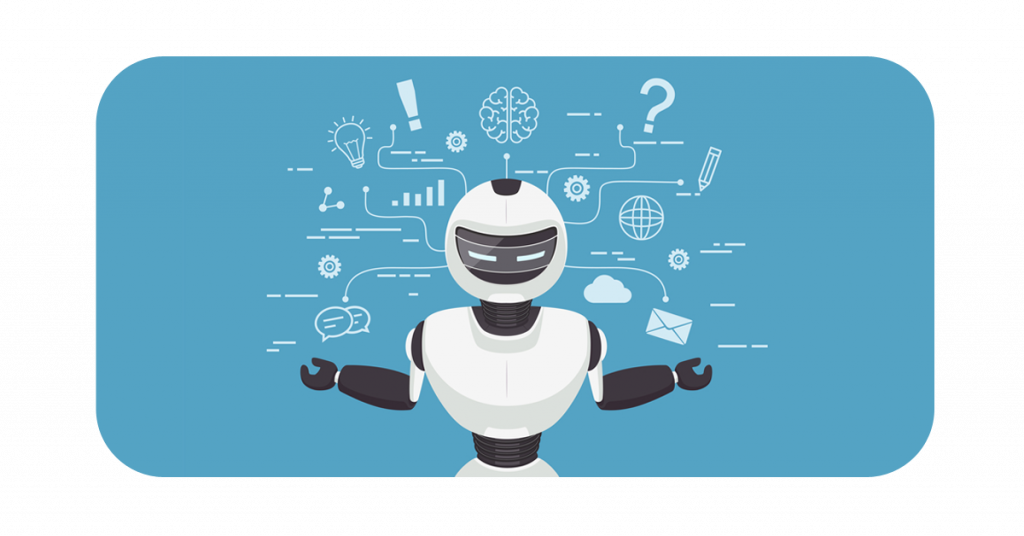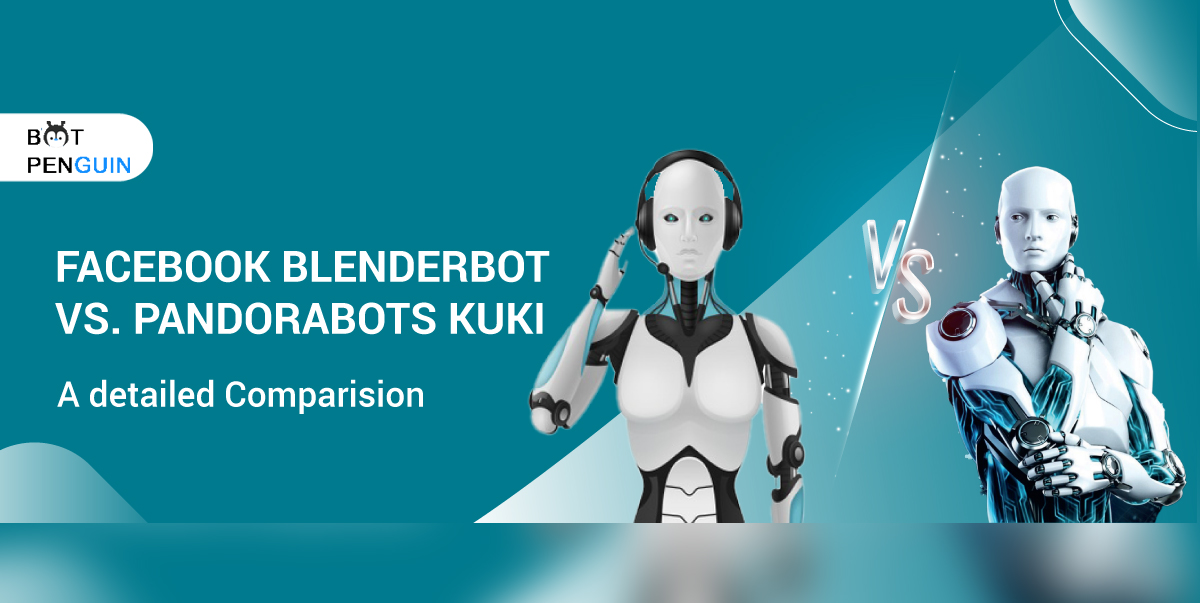Artificial intelligence and automation are the latest faces of the modern world. In a world that is always connected through the internet, virtual identities have become the latest fad. It doesn't come as a surprise that software exists that can chat and behave like humans and can even be assigned virtual identities. They can assist and interact with other similar software as well as humans. Such software are called chatbots, and they are fast taking over the world.
There are many chatbots available in the market, Facebook Blenderbot and Pandorabots Kuki (aka Mitsuku) have made some heads turn. In this article, you will find a detailed comparison between Blenderbot and Kuki. But before that, let’s have a brief idea about chatbots.
What is a Chatbot?
A chatbot is an artificial intelligence software that sends automated messages and can resemble human communication. Chatbots are the latest technology, benefiting different businesses. Have you ever talked with a chatbot? AI Chatbots are great fun and exciting to interact with.
Two of the most advanced chatbots that exist right now are the Blenderbot and Mitsuku A.K.A Kuki. But both of them are very different from each other yet fall in the same category. So let's get to know more about them in-depth.
Also Read:
1. Overview

Facebook developed its own open-source chatbot AI after years of research. Blenderbot gets its name from the fact that it can combine several communication skills. This is the first chatbot to combine a wide set of conversational skills, including empathy, knowledge, and personality, in one system.
Mitsuku AKA Kuki is the most popular online chatbot, and it has won the Loebner Prize Turing Test five times. It's one of the best AI-powered chatbots out there. Kuki chatbot makes use of the A.L.I.C.E. (Artificial Linguistic Internet Computer Entity) database. It also uses advanced machine learning techniques to improve its conversation skills. Compared to other open-domain chatbots with multi-billion parameter models from Google, Facebook, and Open AI, the Mitsuku chatbot, or ‘Kuki,' answers requests in real-time, with practically minimal latency. Kuki can also be extended with third-party APIs (for example, Wikipedia) and knowledge and databases.
2. Architecture
BlenderBot is based on an encoder/decoder or seq2seq neural architecture. Still, instead of using a single encoder to map text input into a context space, it uses many encoders to map text input and data from dialog history, internet searches, and the bot's memory. To produce text output, the aggregated context from the numerous encoders is decoded. Data is generated by a separate decoder module and kept in memory. A program that produces search queries to retrieve information from the internet and memory is also included.
Steve Worswick first designed Kuki (short for Mitsuku) utilizing Pandorabots' underlying AI chatbot technology. Kuki includes several chatbot modules, such as operator and namespace bots that may route traffic across the network. This Pandorabots-invented modular design enables Kuki to be superficially white-labeled by changing about sixty "persona" elements within a front-end persona module.
3. Features

Features of Pandorabots Kuki chatbot:
- Symbolic reduction
- Targeting cycle for refined bot personality
- Chat Log Retention
- Application API
Features of Facebook’s Blenderbot:
- Large Scale training
- Blending techniques
- Generational strategies
- Long-term local memory scale
- Internet access to augment knowledge
Also Read:
4. Conversational Maturity
Every day, chatbots practice the art of conversation. The Blenderbot and Kuki have been well trained for this as well.
In fact, Blenderbot can produce contextual internet search queries during a discussion, read the results, and use that information to respond to people's questions and remarks. This ensures that the chatbot remains updated in an ever-changing world. The Blenderbot gathers conversations in long-term memory and uses them in the upcoming interactions. The knowledge is kept separate for each individual it communicates, ensuring that no new information learned in one interaction is repeated in another.
Kuki is an engagement-oriented chatbot by design, capable of carrying on an open-domain dialog with the overarching goal of delivering on the uniquely human value propositions of conversation: companionship, connection, entertainment, education, and other non-transactional use cases, in contrast to most task-oriented chatbots used for business automation. Kuki has a CPS of 64, three times greater than Microsoft XiaoIce, a prominent Chinese language chatbot. In addition, Kuki can learn local details from a user during a chat, but not globally without the agreement of a human supervisor. Kuki also employs cutting-edge abuse detection and deflection strategies which is a great safety measure.
5. Interactions

BlenderBot was substantially more interesting than any other competition, including Google's Meena, according to human testers, who said they'd prefer to engage it in a protracted conversation. Blender uses its skills to develop an emotional connection with its users, which makes them more interested in the interaction.
Kuki is the most popular English social chatbot in the world. It has over one billion messages exchanged with 25 million human users over the web. Sentiment analysis and emotional markup tags can be used to infer and respond to the end-user emotional state in real-time. User message reactions are used to obtain further user sentiment. Kuki has been featured in several high-profile journals and newspapers, several of them reporting on the profound, long-term emotional bonds she has formed with her human subjects.
6. Blending Skills
Blenderbot was honed in a Blended Skill Talk (BST) challenge, which entails a mixture of three skills: expressing a distinct personality, applying past knowledge, and demonstrating empathy. This strategy is difficult since it requires you to know when to use each of these skills. For example, the system should distinguish between folks who want to be heard and those who ask a rhetorical inquiry rather than a genuine one.
Kuki is primarily implemented using Artificial Intelligence Markup Language (AIML). This open standard rule-based scripting language entails hand-authoring chatbot replies in response to an analysis of incoming user input data using a combination of statistical models, machine learning, and manual review/tagging. This hybrid methodology has many critical benefits, including near-zero response latency, toxicity and corruption resistance, and overall compatibility for brand-appropriate production use cases.
7. Generation Strategies
Perplexity is a measure of how confident a model is in anticipating the next token, and it is used to train chatbots. The generation strategy for training neural models is to reduce perplexity, which is a metric that quantifies how effectively models can anticipate and generate the next word. However, when the model has been trained, researchers often use a variety of generation algorithms, such as beam search, next token sampling, and n-gram blocking, to ensure that conversational agents do not repeat themselves or demonstrate other flaws. In addition, controlling the duration of the chatbot's messages, among other strategies, can increase performance.
Kuki has different generation strategies that appeal to users. The strategies keep context over multi-turn talks, and it may store (and, for compliance purposes, purge) willingly consenting user divulging details in both short-term (e.g., predicates) and long-term (e.g., database) “memory.”
8. Price
The price of Blenderbot for small business marketing can cost somewhere between $50 to $5,000. Some firms spend $50,000 or more on a chatbot. It all depends on the industry, the size of the organization, and the bot's requirements.
Community Service, Shared Service, and Dedicated Service are all options for Pandorabots Kuki chatbot. The community service package is free and includes all of the features of the paid versions, except performance guarantees and customization options for the AI chatbot's gender, personality, and age. The monthly fee for the Dedicated service plan is $1500. This plan includes unlimited chat exchanges, startup customization, and a one-month log retention period.
Also Read:
Conclusion
AI Chatbots vary from each other. Messaging consumers is one of the most time-consuming chores for internet businesses. The idea to use chatbots to automate it arose out of need. If you aim to automate routine tasks, then Blenderbot is the way to go. Mitsuku is a Pandora-based chatbot that has won several awards. Pandora is the best platform available for developing your own AI chatbot.











